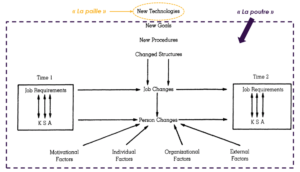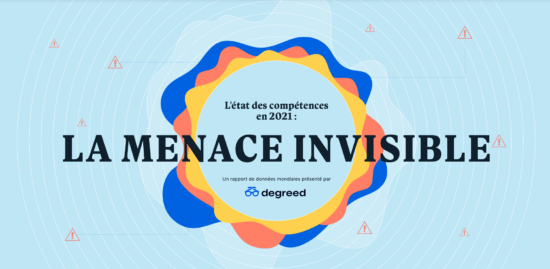Skills obsolescence: mote and beam in Skills Management
Are you worried about the obsolescence of skills due to technological change? The level of maturity that companies have today on this issue will terrify you! Why are they now forced to refresh the skills of their teams, and by what means can they develop new ones? Here is the first part of the answer, and a few concrete recommendations to avoid panic.
The Swiss revolutionaries on the reskilling assault
In January 2020, the World Economic Forum kicked-off the “reskilling revolution” from the comfort of its chalet in Davos. Its ambition is to improve access to skills for more than a billion people. What motivates this unprecedented program, which combines proactive public policies (France, Brazil, the Russian Federation, etc.) and sponsorship from giants in the service sector, is that technological change is accelerating and leading to the rapid obsolescence of skills.
Should we be concerned about this at the level of a company? Obviously, it is a risk that needs to be anticipated. But taking a step back to get a complete view of the risk at hand does not hurt either. Competence is the object of a market; it is offered and demanded. And the threat to skills is often seen on the demand side: “My job is going to disappear”; “Tomorrow, we will all be replaced by machines”, “We need Data Scientists everywhere”, etc.
In its most common sense, obsolescence is therefore essentially seen through the prism of a skill that is no longer needed because it has been replaced by technology. It is not a question of denying this phenomenon, but rather of relativizing it, because, as Michel Audiard would say: “there are also flying fishes, but they do not constitute the majority of the kind”.
Technology, just one of the many factors that explain obsolescence
If we take a closer look at the reasons that lead to the obsolescence of a skill in a company, we quickly realize that the emergence of new technologies is only one of the many factors that step in. We often say that diagram is better than a long explanation, so here is a way to represent visually the situation:

To summarize: there are ten categories of factors that influence the obsolescence of skills in companies. Among them, on the demand side, the famous technology, but also organizational changes or “job requirements”. On the supply side, individual factors, or the availability of skills (KSA or Knowledge, Skills and Abilities).
3 actions to be taken quickly to improve Skill Management
Focusing on the effects of technology-related developments often overlooks the basic issue: being able to know the range of skills available to the company (the famous KSAs).
According to a study published by Degreed, only a third of respondents believe that the skills data in HR systems are up to date. This means that, very often, neither the job requirements in terms of skills nor the KSAs of the workforce are up to date. The starting point of the schema (Time 1) is unknown, obscure or dated.
The state of skills in 2021: the invisible threat
In this study, Degreed explains how the COVID-19 pandemic has changed the working world and forced many employees to refresh their current skills and develop new ones...

So, what to do concretely? In an equation with multiple unknowns, what can be reliably known is always good to take. Here is the list of our 3 Skill Management priorities to get a good idea of your “starting situation”, or “Time 1” in the diagram above:
- Map job requirements in terms of skills (demand);
- Evaluate the availability of skills (KSA) of the employees (offer);
- Define a process and choose a system to store and update this data.
In order to achieve reskilling objectives, it is necessary to be able to measure the path ahead, and this is what knowledge of current capabilities allows. Conducted in collaboration with the business experts, this work also enables them to become more aware of Skill Management and to better accept the evolution of the related processes (performance evaluation, training, transversal mobility, etc.).
Our research on the erosion of skills in companies
Should we give up trying to project the future of skills? Not at all. At Akoya, we think about this daily as part of our mission. We have even published a study carried out by our Disrupt team, and more particularly Christelle, on the impact of Artificial Intelligence on certain cross-functional jobs.
Artificial Intelligence: towards more human jobs
In this study, Akoya interviewed several experts in order to measure the impact of Artificial Intelligence on businesses, and more specifically, the volumetric and repetitive intellectual tasks.

At the present time, we have decided to pursue a new line of research. We are deepening the modeling of what the literature calls wear, i.e. the natural erosion of the supply of skills held by a group of individuals (a team, a business unit, etc.).
It is eroding because of the departure of experts, individuals whose physical or intellectual capacities decline with age, insufficient training to keep cutting edge abilities, and the absence of a pool of external skills to be integrated. Our objective: to be able, once the skills of a given population have been mapped, to model the evolution of the KSA available on a medium-term horizon. To be continued…
Looking at the mote of obsolete skills versus those of the future, we don’t see the beam of the lack of knowledge of organizations about their own skills offering. We are trying to predict the future before we have even made an inventory of the present. The challenge of skills mapping needs and the offer currently available within the teams is still an issue in many companies…
Notes 1 :
Modeling the Skills Obsolescence Process: A Psychological/Economic Integration John A. Fossum, Richard D. Arvey, Carol A. Paradise and Nancy E. Robbins , Academy of Management ReviewVol. 11, No. 2
Pour aller plus loin...
Expertise : cartographie des compétences
Changement de business model, digitalisation, internationalisation, automatisation… autant d’évolutions qui modifient les compétences nécessaires aux métiers d’aujourd’hui et de demain. Sans les compétences adéquates, aucune chance d’atteindre vos objectifs stratégiques. De l’identification à la pérennisation en passant par l’acquisition, l’évaluation et la maîtrise, les défis liés aux compétences sont nombreux; il est essentiel, avant d'entamer toute démarche, d'en définir clairement les objectifs.
Voir plusCas client : les compétences du futur dans l'énergie
Quelles sont les futures compétences stratégiques de la distribution d’énergie ? Akoya a accompagné un acteur incontournable dans le monde de l’énergie dans la création d'un programme de mise à niveau des collaborateurs sur les nouvelles compétences clés du réseau de distribution de demain.
Voir plus